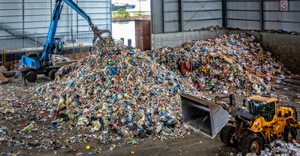Best Laid Plants
Banning plant debris from landfills helps Alameda County boost diversion rate.
April 1, 2010
Tom Padia
In an effort to meet a voter mandate to achieve a 75 percent landfill diversion by the end of 2010, the Alameda County (Calif.) Waste Management Authority (ACWMA) enacted a countywide ordinance prohibiting the disposal of plant debris (a.k.a. yard waste) in landfills. The ordinance defines plant debris as grass, leaves, shrubbery, vines, tree branches and trimmings, and excludes palm, sod and street sweepings. The ban took effect in March 2009, with a 50 percent tip fee surcharge assessed for self-haul violators and potential citations and fines for business and institutional generators.
The ACWMA, operating as "StopWaste.Org," provides solid waste planning and waste reduction programs to the 1.5 million inhabitants of Alameda County, in the San Francisco Bay area. A 1990 voter-approved ballot initiative set a 75 percent and beyond diversion goal for the county, exceeding the California legislative mandate of 50 percent. Using the state calculation method, Alameda County and its 14 cities achieved an overall 67 percent diversion rate in 2008.
A waste characterization study conducted throughout 2008 showed 68,000 tons of plant debris were landfilled that year, not including approximately 30,000 additional tons used for alternative daily cover or erosion control at the three active, privately-owned landfills in the county. The amount of plant debris landfilled in Alameda County has declined steadily from 1995, when 176,000 tons were disposed of. Residential yard waste collection programs have expanded, discounted "clean green" tip areas have been established at disposal facilities, and "chip and ship" operations providing fuel to Central Valley biomass power plants have opened to accept woody materials. Approximately two-thirds of the plant debris still landfilled is delivered to disposal facilities by self-haulers or in debris boxes, with another 15 percent collected from commercial refuse accounts.
ACWMA decided to move ahead with its countywide landfill ban when it became apparent that California was unlikely to join the 23 other states that have passed similar statewide bans, leaving the county very few options to meet its 75 percent diversion goal by the end of 2010. StopWaste.Org staff estimate that approximately 75 percent of all plant debris currently generated already is diverted from landfills. The goal of the ban is to divert the remaining 25 percent and get the county closer to its 75 percent goal.
The ordinance requires haulers and solid waste facility operators to file approved "compliance plans" with StopWaste.Org describing how they will cooperate with the enforcement of the ban. Plans include elements such as signage and information dissemination; offering self-haulers the opportunity to separate "significant quantities" of plant debris from the rest of their load and assessing penalty surcharges on those who refuse to do so; conducting random load checks; and providing assistance in identifying violators. Fines will be $100, $200 and $500 for first, second and repeat violations within a year, respectively. The goal of the ordinance is compliance, not the collection of fines; thus violators will be given a written warning before any fine is levied. ACWMA estimates that fines may be issued at a rate of a few dozen per year.
The first year has been spent conducting intensive outreach with landscapers, property managers, florists, cemeteries, golf courses, park districts, local public works and parks and recreation departments, chambers of commerce, self-haulers at transfer stations and landfills, and commercial waste generators throughout the county. Last summer and fall, contractors were hired to randomly visit transfer stations and landfills to hand out information about the ban. They also rewarded landscapers and large self-haulers bringing in clean loads of plant debris with leather gloves and canvas tarps emblazoned with the StopWaste.Org landfill ban logo.
Local landscapers and the other targeted groups have been overwhelmingly receptive to the landfill ban; in fact, most had already been separating their plant debris for economic reasons.
One local city public works department reports that, prior to separating their plant debris, it was sending, on average, 19 tons per week of refuse to a landfill. Despite years of cajoling from city recycling staff, maintenance division staff stubbornly cited space and time constraints as reasons why they could not separate the plant debris. A management change and the new ordinance resulted in a decrease to less than five tons per week of garbage and 150 tons of plant debris sent to a composting facility during a six-week period at the height of the leaf season.
One noteworthy finding has been the extent to which park districts, community colleges, transit agencies and other large institutions and enterprises already engage in on-site mulching, composting and grass-cycling for the bulk of their plant debris generation. These kinds of practices, together with compliance with the new ordinance, will help build a local sustainable economy and help Alameda County achieve its goal of "75 percent and beyond" diversion from landfills. For more information about the ban, go to www.LandfillBan.org.
Tom Padia is recycling director at StopWaste.Org and has worked in recycling since 1981, serving in the non-profit, private and public sectors. He can be reached at [email protected].
Related Stories
You May Also Like


